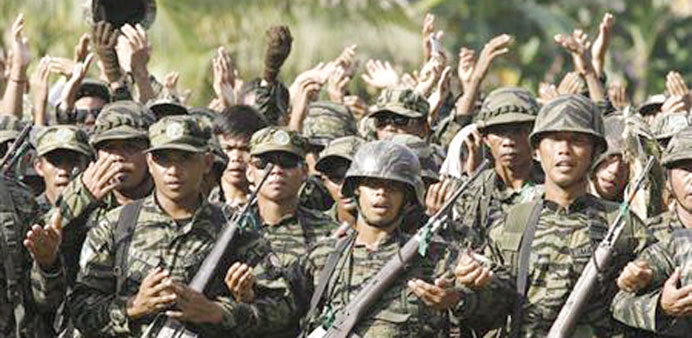Moro Islamic Liberation Front rebels pray as they gather in celebration of a peace deal signing, at Camp Darapanan in Maguindanao province, southern Philippine.
By Catherine S Valente/Manila Times
Months after the infamous Mamasapano incident, many Filipinos still believe that talking peace rather than waging a war is a “more effective” way of dealing with the Moro Islamic Liberation Front (MILF).
A Social Weather Stations (SWS) survey conducted from March 20 to 23 found that 45% of Filipinos prefer peace negotiations with the MILF while only 20% believe that the government should undertake military action against the group.
The remaining 35% said military operations and peaceful negotiations are equally effective.
“In 12 national surveys since December 1999, peaceful negotiations have consistently been seen as more effective in dealing with the MILF compared to military operations,” the SWS noted.
The survey was conducted amid ongoing controversy surrounding the death of the 44 commandos of the Philippine National Police-Special Action Force in Mamasapano, Maguindanao, last January.
But the SWS also noted that those who said peaceful negotiations are more effective declined by 17 points from 62% during the same period in 2014.
On the other hand, those who prefer military operations rose 11 points from 9%, while those who said military operations and peaceful negotiations are equally effective rose six points from 29%.
Despite the recent drop in March 2015, the ratio of those who prefer peaceful negotiations to those who prefer military operations is two to one, SWS pointed out.
On issues about peace efforts compared to December 2014, the administration’s net rating is down by 18 points from +40 on defending the country’s territorial rights; down by 18 points from +15 on reconciliation with rebels; and down by 20 points from +17 on reconciliation with communist rebels.
The SWS also noted 48% of Filipinos were satisfied, 23% neither satisfied nor dissatisfied and 29% dissatisfied with the national government’s performance in general.
This resulted in a net satisfaction rating of +19 (percent satisfied minus percent dissatisfied), which the SWS considers “moderate.”
It was a 15-point fall and a one-grade downgrade from the “good” +34 (58% satisfied, 29% dissatisfied) in December 2014.
The SWS considers scores of +70 and above as “excellent”; +50 to +69 “very good”; +30 to +49 “good”; +10 to +29 “moderate”; +9 to -9 “neutral”; -10 to -29 “poor”; -30 to -49 “bad”; -50 to -69 “very bad”; and -70 and below “execrable.”



